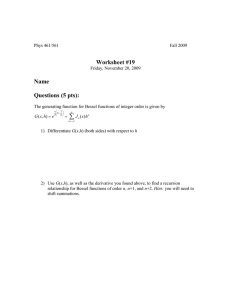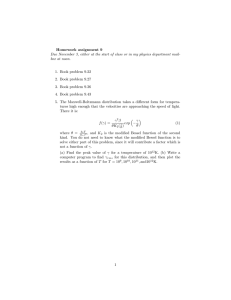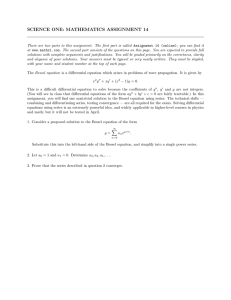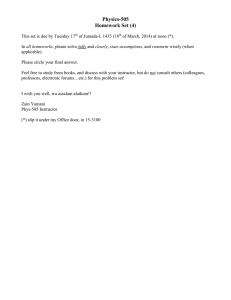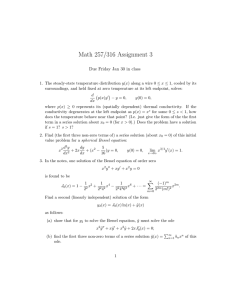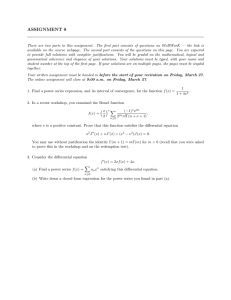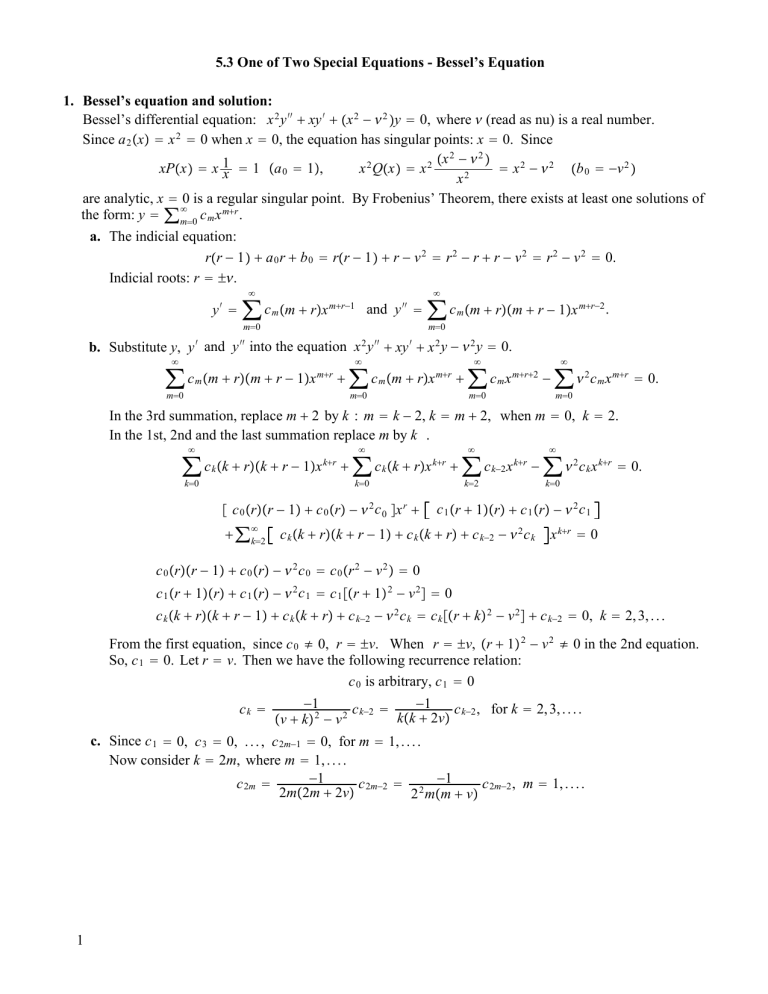
5.3 One of Two Special Equations - Bessel’s Equation 1. Bessel’s equation and solution: Bessel’s differential equation: x 2 y UU xy U x 2 " 7 2 y 0, where 7 (read as nu) is a real number. Since a 2 x x 2 0 when x 0, the equation has singular points: x 0. Since x 2 " 7 2 xPx x 1x 1 a 0 1 , x 2 Qx x 2 x 2 " 7 2 b 0 "v 2 x2 are analytic, x 0 is a regular singular point. By Frobenius’ Theorem, there exists at least one solutions of . the form: y ! m0 c m x mr . a. The indicial equation: rr " 1 a 0 r b 0 rr " 1 r " v 2 r 2 " r r " v 2 r 2 " v 2 0. Indicial roots: r o7. . yU . ! c m m r x mr"1 and y UU m0 ! c m m r m r " 1 x mr"2 . m0 b. Substitute y, y U and y UU into the equation x 2 y UU xy U x 2 y " 7 2 y 0. . ! c m m r m r " 1 x m0 . mr ! c m m r x . mr m0 ! cmx . mr2 m0 " ! 7 2 c m x mr 0. m0 In the 3rd summation, replace m 2 by k : m k " 2, k m 2, when m 0, k 2. In the 1st, 2nd and the last summation replace m by k . . . . . k0 k0 k2 k0 ! c k k r k r " 1 x kr ! c k k r x kr ! c k"2 x kr " ! 7 2 c k x kr 0. ¡ c 0 r r " 1 c 0 r " 7 2 c 0 ¢x r . ! k2 c 1 r 1 r c 1 r " 7 2 c 1 c k k r k r " 1 c k k r c k"2 " 7 2 c k x kr 0 c 0 r r " 1 c 0 r " 7 2 c 0 c 0 r 2 " v 2 0 c 1 r 1 r c 1 r " 7 2 c 1 c 1 ¡r 1 2 " v2¢ 0 c k k r k r " 1 c k k r c k"2 " 7 2 c k c k ¡r k 2 " v 2 ¢ c k"2 0, k 2, 3, . . . From the first equation, since c 0 p 0, r ov. When r ov, r 1 2 " v 2 p 0 in the 2nd equation. So, c 1 0. Let r v. Then we have the following recurrence relation: c 0 is arbitrary, c 1 0 ck "1 "1 c k"2 c k"2 , for k 2, 3, . . . . kk 2v v k 2 " v 2 c. Since c 1 0, c 3 0, . . . , c 2m"1 0, for m 1, . . . . Now consider k 2m, where m 1, . . . . "1 c 2m"2 2 "1 c 2m"2 , m 1, . . . . c 2m 2m2m 2v 2 mm v 1 m 1, c 2 "1 c0 2 2 1 1 v m 2, c 4 "1 2 "1 c c0 2 2 2 2 2 v 2 22 2!2 v 1 v : "1 m c0 2 2m m!m v m " 1 v . . . 1 v m m, c 2m . ! c 2m x yv . c0 ! 2mv m0 . m0 "1 m x 2mv 2 2m m!m v m " 1 v . . . 1 v . "1 m v 1 2 v "1 m x 2mv c 0 v 1 2 v ! 2mv x 2mv 2mv 2 m!m v 1 2 m!m v 1 m0 c0 ! m0 . c0 ! 2 m0 2mv "1 m x 2mv m!m v 1 . Gamma function: x ; t x"1 e "t dt 0 Properties: i x 1 xx ; ii n 1 n! It is also called the generalized factorial. TI-89: ;t^x " 1 ' e^"t , t, 0, . Example Evaluate 1 2 1 2 5 2 and . = TI-89: ;t^"1/2 ' e^"t , t, 0, . 5 2 3 2 1 3 2 3 2 (use (-) for –) 3 2 1 1 2 3 2 1 2 1 2 3 4 = 1. 329 34 2. The General Solution of Bessel’s Differential Equation: Let . J v x ! m0 . "1 m "1 m x 2mv x v ! 2mv x 2m for x in I. 2mv 2 m!m v 1 2 m!m v 1 m0 Since x 0 is the only singular point of Bessel’s equation, the radius of convergence R is . and therefore the interval of convergence I is either "., 0 or 0, . . J v x is called the Bessel function of the first kind of order v. Case 1. If v is not an integer, a general solution of Bessel’s equation for all x p 0 is y C 1 J v x C 2 J "v x . Case 2. If v is a nonnegative integer, say v n, then S . J n x ! m0 2 "1 m x 2mn X 2 2mn m!m n ! n 2 1 =x cosx " = 2 4 2 1 0 10 20 30 x 40 50 60 -1 -2 J n x red n 0, green n 1, blue n 2 J x 0. lim xv. n S Note that J "n x "1 n J n x which can be shown as follows. . J "n x ! m0 "1 m x 2m"n 2m"n 2 m!m " n ! . ! mn 2 2m"n "1 m x 2m"n m!m " n ! Let m s n s m " n . Then . J "n x ! mn . ! s0 "1 m x 2m"n 2 2m"n m!m " n ! . ! s0 "1 sn x 2sn "1 2 2sn s n !s! "1 sn x 2sn "n 2 2sn "n s n !s n " n ! . n ! m0 "1 m x 2mn "1 n J n x . 2 2mn m n !m! Since J "n x "1 n J n x , J n and J "n are linearly dependent. Define 1 Y v x ¡J v x cosv= " J "v x ¢, v may not be an integer. sinv= Y v x is called the Bessel function of the second kind of order v. The another form of the general solution: y C 1 J v x C 2 Y v x . 2 J 0 x Y 0 x = 3 + ln x 2 2 " = . ! k1 "1 k 1 1 . . . 1 x 2k , 2 k 2 2k k! 2 + 0. 57721566 2 J n x Y n x = n " x= . ! k0 n"1 "n " x= + ln x 2 "1 k 2 2kn k!k n ! ! k0 n " k " 1 ! 2k x 2 2k"n k! 1 1 . . . 1 2 k 1 1 . . . 1 2 kn x 2k , + 0. 57721566. Since Y n x lim Y x , v¯n v when v n, y C 1 J n x C 2 Y n x . 3. Properties of Bessel Functions: a. J "n x "1 n J n x b. J n "x "1 n J n x (when n is even, J m is even, and when n is odd, J m is odd. ) U U U c. xJ v x vJ v x " xJ v1 x , J 0 x "J 1 x , Y 0 x "Y 1 x 9x 2 y UU 9xy U 9x 2 " 1 y 0. 4 It is not in a Bessel equation form yet. Divide both sides of the equation by 9 : 9x 2 y UU 9xy U 9x 2 " 1 y 0 ® x 2 y UU xy U x 2 " 1 y 0 4 36 This is a Bessel equation with v o 1 . Since v is not an integer, 6 y C 1 J 1 x C 2 J " 1 x 6 6 Example Find the general solution of the equation: . C 1 x 1/6 ! m0 C 1 x 1/6 1 2 1/6 C 2 x "1/6 C 1 x 1/6 "1 m 1 2 2m 6 m!m 7 6 1 2 "1/6 " 5 6 . 7 6 1 2 13/6 " x 2m C 2 x "1/6 ! m0 13 6 1 2 11/6 x2 11 6 2 1 2 25/6 x2 2m" 1 6 19 6 1 2 23/6 "1 m m!m 5 6 x 2m x 4 ". . . 17 6 x 4 ". . . 0. 960 311 " 0. 205 781 x 2 0. 02 37x 4 " C C 2 x "1/6 0. 994 397 " 0. 298 319 x 2 0. 0407 x 4 . . . Example Consider the differential equation x 2 y UU xy U 2x 2 " 1 y 0. 9 dy d2y , and 2 . dz dz ii Find the general solution in z with expressing the first 3 nonzero terms for each solution. iii Find the general solution in x with expressing the first 3 nonzero terms for each solution. i Set z 2 x and rewrite the differential equation as a Bessel equation in z, i The equation x 2 y UU xy U 2x 2 " 1 y 0 is not in a Bessel equation form. 9 Let z 2 x. Then we have the following substitution: 4 z , and dz dx 2 x dy dy dz dx dz dx and the equation becomes: yU 2 dy , dz y UU 2 z 2 2 d y 2 dz 2 which is a Bessel equation in z: 2 dy U dy U dz dy d 2 dz dx dz dx dz 2 2 d2y dz 2 z 2 dy z 2 " 1 y 0, 9 dz 2 z 2 y UU zy U z 2 " 1 y 0, v o 1 3 9 1 ii Since 7 o 3 , the general solution of the differential equation is: y C1J 1 2 x c2J" 1 2 x 3 . C1 ! m0 3 . 1 "1 2 x 2m 3 1 2 2m 3 m!m 1 m . C 1 x 1/3 ! m0 . C 1 x 1/3 ! m0 C2 ! 1 3 m0 . 1 "1 m 2 m 6 1 2 2m 3 m!m 2 m 1 6 "1 m m!m 1 "1 m 2 x 2m" 3 1 2 2m" 3 m!m 1 " 1 "1 m 2 m" 6 1 2 2m" 3 m!m x 2m C 2 x "1/3 ! 4 3 m0 . x 2m C 2 x "1/3 ! 4 3 m0 1 3 2 m" 1 6 "1 m m!m 2 3 x 2m 2 3 x 2m iii y C 1 x 1/3 1 2 1/6 0! 43 C 2 x "1/3 C 1 x 1/3 C 2 x "1/3 " 1 x 2 13/6 1 10 x 4 " C 2 7/6 1! 73 2 2! 3 1 2 "1/6 0! 23 " 1 x 2 11/6 1 8 x 4 " C 2 5/6 1! 53 2 2! 3 0. 9958 " 0. 3734x 2 0. 0400x 4 " C 0. 8299 " 0. 6224x 2 0. 0934x 4 " C Example Consider the differential equation 4x 2 y UU 4xy U x " 1 y 0. 36 dy d2y , and 2 . dz dz ii Find the general solution in z with expressing the first 3 nonzero terms for each solution. iii Find the general solution in x with expressing the first 3 nonzero terms for each solution. i Set z x and reduce the differential equation to a Bessel equation in z, i The equation 4x 2 y UU 4xy U x " 1 y 0 is not a Bessel equation. 36 Let z 2 x. Then we have the following substitution: dy 1 z x , or x z 2 , and dz 1 dz 2z dx 2 x yU y UU 5 dy U dy U dz d dx dz dx dz dy dy dz dy 1 dx dz dx dz 2 x 1 dy 2z dz dz dx dy 1 2z dz dy "1 d2y 1 2 2z dz 2z 2 dz 1 2z 2 1 d y " 1 dy 4z 2 dz 2 4z 3 dz and the equation becomes: dy d2y 4z 4 1 2 " 13 4z dz 2 4z dz which is a Bessel equation in z: 4z 2 dy 1 z 2 " 1 y 0 36 dz 2z v o1 z 2 y UU zy U z 2 " 1 y 0, 6 36 1 ii Since 7 o 6 , the general solution of the differential equation is: y C1J 1 x C2J" 1 x 6 6 . "1 m x C1 ! 1 2 2m 6 m!m 1 m0 . C1 ! 2 m0 2m 16 . C1x 1/12 . 2m 16 ! m0 "1 m m!m 1 6 m0 2 . x m 12 C 2 ! 1 7 6 m0 "1 m 1 2 2m 6 m!m 2m" 16 "1 m x C2 ! 2m" 16 2 2m" 16 "1 m m!m . m x C2x 7 6 "1/12 1 6 m!m 1 " ! m0 2 2m" 1 6 1 x m" 12 5 6 "1 m m!m 5 6 xm iii y C 1 x 1/12 C 2 x "1/2 c 1 x 1/12 c 2 x "1/12 1 2 0! 76 1/6 2 "1/6 1 0! 56 " " 2 13/6 2 1 x 25/6 1 19 x 2 " C 13 2 2! 6 1! 6 11/6 1 x 23/6 1 17 x 2 " C 11 2 2! 6 1! 6 0. 9006 " 0. 1930x 0. 0111x 2 " C 0. 9984 " 0. 2995x 0. 0204x 2 " C . Example Verify that y x n J n x is a particular solution of the equation: xy UU 1 " 2n y U xy 0. Find a particular solution of the equation: xy UU " y U xy 0. Check: U U U UU y U nx n"1 J n x x n J n x , y UU nn " 1 x n"2 J n x nx n"1 J n x nx n"1 J n x x n J n x xy UU 1 " 2n y U xy xnn " 1 x n"2 J n x nx n"1 J Un x nx n"1 J Un x x n J UUn x 1 " 2n nx n"1 J n x x n J Un x xx n J n x "n 2 x n J n x 2n J UUn x n1 J Un x 2n J n x n x 2 J UUn x xJ Un x x 2 " n 2 J n x 0 xy UU " y U xy xy UU 1 " 21 y U xy 0, n1 A particular solution is: . y x J 1 x x ! 1 m0 "1 m x 2m1 2 2m1 m!m 1 ! . ! m0 "1 m x 2m2 2 2m1 m!m 1 ! 1 x 2 " 1 x 4 1 x 6 ". . . 16 2 384 Example One mathematical model for the free undamped motion of a mass on an aging spring is given by my UU ke ")t y 0, where ) 0. 6 2 k e ")t/2 . Reduce the differential equation to a Bessel equation in s. i Let s ) m ii Find the general solution of the differential equation in a series form. iii Solve the initial-value problem: 4y UU e "0.1t y 0, y0 1, y U 0 " 12 . i The equation my UU ke ")t y 0 is not a Bessel equation. ds 2 ) dt k m " ) e ")t/2 " 2 k ")t/2 " ) s, m e 2 k e ")t/2 ) 2 s. d 2 s " k " ) e ")t/2 ) m m 2 2 2 dt 2 dy ds dy dy , ")s 2 ds dt dt ds d2y dy dy dy ds d ")s ")s d d 2 2 dt dt ds dt ds dt ds dt 2 2 2 2 2 dy dy d y ds d y ") ")s ")s ) s 2 2 2 2 2 2 ds ds dt ds ds d2y 2 ke ")t/2 y 2 dt 2 ) 2 s 2 d y ) 2 s dy k s ) m m 2 2 2 k ds ds 2 2 2 d y dy s2 2 s s2y 0 ® m ) 2 ds ds d2y d2y dy dy s2 2 s s2y 0 ® s2 2 s s 2 " 0 y 0, v 0. ds ds ds ds ii The general solution is: my UU ke ")t y m 2 ) y C 1 J 0 s C 2 Y 0 s C 1 J 0 iii 4y UU e "0.1t y y UU 1 e "0.1t y 0, 4 k ")t/2 m e C2Y0 2 ) 2 y k ")t/2 m e y U 0 " 12 . y0 1, 2 ) 0. 1, m 4, k 1. s ) k ")t/2 2 m e 0. 1 1 e "0.1t/2 10e "0.05t 4 y C 1 J 0 10e "0.05t C 2 Y 0 10e "0.05t , U U y U C 1 "0. 5e "0.05t J 0 10e "0.05t C 2 "0. 5e "0.05t Y 0 10e "0.05t y0 C 1 J 0 10 C 2 Y 0 10 C 1 "0. 2459 C 2 0. 0557 1 y U 0 "0. 5C 1 "J 1 10 " 0. 5C 2 "Y 1 10 0. 5C 1 0. 0435 0. 5C 2 0. 2490 " 1 2 C 1 "0. 2459 C 2 0. 0557 1 0. 5C 1 0. 0435 0. 5C 2 0. 2490 " 12 2 J 0 x Y 0 x = + ln x 2 2 " = . ! k1 , C 1 "4. 786 962 C 2 "3. 179 788 "1 k 1 1 . . . 1 x 2k , + 0. 57721566 2 k 2 2k k! 2 y "4. 786 962J 0 10e "0.05t " 3. 179 788Y 0 10e "0.05t Let 7 . J 0 x ! m0 "1 m x 2m X 1 " 1 x 2 1 x 4 4 64 2 2m m!m ! 2 1 " 1 x 2 1 x 4 + ln Y 0 x X = 4 64 2 " 1 1 x 2 1 1 " = 4 164 2 1 " 1 x 2 1 x 4 + ln = 4 64 1 2 y X "4. 786 962 = 1 " 10e "0.05t 2 4 " 3. 179 788 1 2 "0.05t = 1 " 4 10e 2 x 2 1 x4 1 1 1 1 x6 2 2 3 6436 2 " 1 x 2 3 x 4 11 x 6 x " = 4 128 13 824 2 1 10e "0.05t 4 64 10e "0.05t 4 1 10e "0.05t + ln 2 64 2 " 1 10e "0.05t 2 3 10e "0.05t 4 11 10e "0.05t 3. 179 788 = 4 128 13 824 625 2 "0.1t "0.2t e "4. 786 962 = 1 " 25e 4 2 1 " 25e "0.1t 625 e "0.2t ¡+ ln5e "0.05t ¢ " 3. 179 788 = 4 1875 2 "0.1t e "0.2t 171 875 e "0.3t 3. 179 788 = "25e 8 216 1 0.8 0.6 0.4 0.2 0 8 2 4 6 8 10 t 12 14 16 18 20 6
